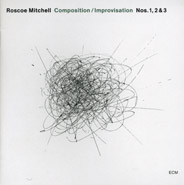Roscoe Mitchell
Composition/Improvisation Nos. 1, 2 & 3
(ECM)
A
"modern classic", Roscoe Mitchell is today the perfect specimen
of the "permanent avant-garde" category: a definition (which if
I'm not mistaken was coined by US music critic Francis Davis when talking
about Ornette Coleman) which in a nutshell defines a group of musical innovations
destined to never be accepted by the mainstream.
Though
his musical status has always been on the marginal side commercially, Mitchell
has never accepted defeat, maintaining throughout his life a very high
quality standard, both live and in the studio. Here I have to mention his
innovative work titled Sound (1966), and also the later album Fanfare For
The Warriors (1974, in my opinion the best recorded example of what made
the collective called The Art Ensemble Of Chicago really special. Today's
Mitchell can be as good as the old one, if not better, as demonstrated
on Nine To Get Ready (1999) and Song For My Sister
(2002), two albums recorded by a
"variable line-up" nonet called The Note Factory, and on the recent
Turn (2005), for quintet.
It's
information that start to go missing, hence a perennial sense of doubt
about not knowing about some new release; it would be quite bizarre if
what the future held in store was a discography "à la Lacy",
with a CD released in France for French people, one in Italy for Italian
people, one in Japan for Japanese people, and one in the States for American
people; a weird outcome in a world where there's nothing easier than buying
an album on the Net, but where the overabundance of information at one's
disposal thanks to the Net makes it quite easy for one to lose his/her
way. So we have to welcome an album that has quite a bit of visibility.
I
have to confess I had completely forgotten about this "transatlantic
project" I had heard about a few years ago (those who believe in the
existence of subconscious can start formulating their hypothesis): a collaboration
between Roscoe Mitchell and Evan Parker, with the presence of some of their "trusted
musicians". Booklet notes talk about some
"specially commissioned pieces": a definition that coupled with
the expression "World Premiere" makes me automatically prepare
for the worst. I have to say the liner notes appeared to me as being quite
brief and on the elusive side, especially if one considers the fact that
the booklet has quite a few pages, mostly filled with pictures; having a
look on the Net - on the label's site, and on the one of the Festival that
commissioned the works - didn't really make feel satisfied. (And what's that,
anyway: one is supposed to fork eighteen euros, only to have to look for
information on the Net?)
For
this "Transatlantic Art Ensemble" Mitchell (soprano sax) has
called some of his regular collaborators: Tani
Tabbal (drums and percussion), Jaribu Shahid (double bass), Craig Taborn
(piano) and Corey Wilkes (trumpet and flugelhorn); Anders Svanoe (alto
and baritone sax) and Nils Bultmann (viola) had played on the aforementioned
Song For My Sister. We have Evan Parker (soprano and tenor sax) and some
musicians whose name I associate with Parker's: Neil Metcalfe (flute),
Philipp Wachsmann (violin), Marcio Mattos (cello), Barry Guy (double bass)
and Paul Lytton (drums and percussion). I have to confess I'm not really
familiar with John Rangecroft (clarinet).
The
title of the album being Composition/Improvisation Nos. 1, 2 & 3, we
are in Mitchell's territory known as "scored improvisation".
The funny thing is that, in so differently from what it had happened to
me in the past (but I've never listened to pieces composed by Mitchell
as performed by classical ensembles), I noticed that had I listened to
some of this music during a
"blindfold test" I would not have been able to recognize what I
was listening to; while at other times I would have thought about some line-up
led by Evan Parker. Maybe it's just an issue of instrumental colours?
The
album (which, at eighty minutes long, is way too long) features eight tracks
of different length. I was a bit puzzled by the thirteen minute long piece
I, mostly for strings, both solo and ensemble. In the brief II three minutes
for percussion are followed by one minute of winds appearing one by one,
as lights in the darkness: a compositional gesture that's highly personal,
and definitely Mitchell. The long III (eighteen minutes) starts, strangely
enough, as a mixture of Swing & Varèse which in different circumstances
I could have mistaken for an unreleased track by Frank Zappa off 200 Motels
or The Grand Wazoo; then we have a long episode with Evan Parker solo on
tenor, which gets progressively surrounded by the whole ensemble for something
that's beautiful and effective but which we've already heard on other albums
by Mitchell.
All
on the brief side, IV, V and VI use the same format: a solo instrument
(clarinet on IV, flute on V, trumpet on VI) which other voices progressively
join; all nice moments, but not really memorable, and sometimes sketch-like.
VII works a lot better: the formula is more or less the same, but a greater
length (nine minutes) and a nice performance on baritone sax have as a
final result what sounds like a mix of old Mitchell performances and some
Mingus aromas for what is the high point of the album.
About
a quarter of an hour long, VIII is not indispensable but it's good all
the same, never boring despite its considerable length; a nice piano, beautiful
trumpet (also played with mute), and an intelligent use of the ensemble.
A somewhat bland track, IX, ends the album: six minutes whose main fault
is maybe that of coming at the end of a long album.
Beppe Colli
© Beppe Colli 2007
CloudsandClocks.net | May 15, 2007











